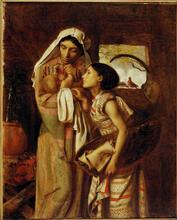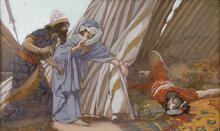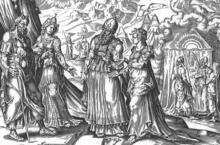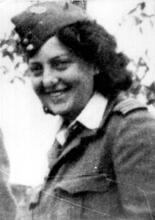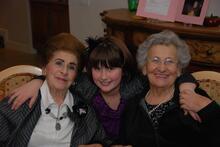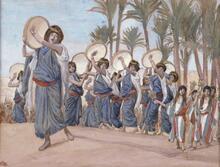Puah: Midrash and Aggadah
Puah was one of the two Hebrew midwives who delivered the children of the Israelites during the Egyptian servitude. The Torah’s only mention of these two midwives is when they disobeyed Pharaoh’s command and did not kill the Israelite male newborn. The Rabbis link the midwives with various Biblical heroines, thereby transforming them from secondary characters to central, fully developed figures whose annals spread over additional chapters of the Torah. One midrash credits Puah’s name to her midwifery skills; another bases her name on an insolent act towards her father. Different midrashic traditions identify the various ways in which Puah as rewarded for her bravery, and several mention her familial connections to many important biblical figures.
Identities of Puah and Shiphrah
According to one Rabbinic position, Shiphrah and Puah were mother and daughter: Jochebed and Miriam; according to another view, daughter-in-law and mother-in-law: Jochebed and Elisheba, daughter of Amminadab. In both identifications, these are prominent Hebrew women who were celebrated for their righteousness. These identifications are based on the Biblical account that the midwives did not obey the royal edict because they feared God.
Additionally, God rewarded them for their actions, as verse 21 attests: “He established households [battim] for them,” which the Rabbis understand as priestly and Levitical households, or as royal households. This in turn led the exegetes to conclude that the midwives were connected with the leadership of the generation that went forth from Egypt, along with the priests and Levites. Jochebed, Miriam, and Elisheba were indeed related to these leading families (BT Suspected adulteressSotah 11b).
However, according to one unique tradition, Shiphrah and Puah were non-Jewish midwives, who were said to be pious women and true converts (A type of non-halakhic literary activitiy of the Rabbis for interpreting non-legal material according to special principles of interpretation (hermeneutical rules).Midrash Tadshe, Ozar ha-Midrashim [Eisenstein], p. 474). This tradition would read the phrase “the Hebrew midwives” as “the midwives of the Hebrew women.”
Name
The majority of the Rabbinic traditions maintain that Puah was a Hebrew woman; some identify her with Miriam, and others, with Elisheba daughter of Amminadab. Why, then, was she called “Puah”? Because she appeared (hofi’a) with good deeds for Israel. For example, she went with her mother to the expectant mother. According to another etymological explanation, she would bleat (poah) like a sheep to the woman in labor, which acted as a stimulus and aided the woman to deliver. Another view has her squirting (nofa’at) wine into the baby’s mouth, or would cause the newborn to cry out when it was thought to be stillborn (Ex. Rabbah 1:13; Eccl. Rabbah 7:3; Midrash Samuel 23:2).
Another explanation of her name relates to her behavior toward Pharaoh. When she heard the royal edict, she was insolent (hofi’ah panim) toward Pharaoh and looked down her nose at him. She told him: “Woe to you on the day of judgment, when God will come to demand punishment of you.” Pharaoh immediately became enraged and wanted to kill her. She was saved thanks to her mother, who mollified him and said to him: “Do you take notice of her? She is a baby, and knows nothing” (Ex. Rabbah, loc. cit.). Another explanation of her name is connected with the birth of Moses. Puah (= Miriam) would cry out (poah) with divine inspiration and say: “My mother shall give birth to a son who will save Israel” (BT Sotah 11b).
In another midrashic account, she was called Puah because of her insolence which, in this depiction, was directed against her father Amram. When Pharaoh ordered the Israelite boys to be cast into the Nile, Amram said: “Shall an Israelite lie with his wife for nothing?” He immediately separated from Jochebed and divorced her. The Israelites saw this action by Amram, who was the head of the Sanhedrin at the time, and subsequently also divorced their wives. Puah told her father: “Father, your decree is harsher than that of Pharaoh! He only decreed against the males, but you have decreed against both the males and the females. It is doubtful whether the decree of the wicked Pharaoh will come to pass, but you are righteous, and so your decree will be fulfilled.” Amram immediately took back his wife, and following his lead, all the other Israelite men did the same. Miriam was accordingly given the name of Puah, since she was insolent (hofi’ah panim) to her father (Ex. Rabbah 1:13). Another tradition explains that she was so named because she cried out (poah) and wept for her brother Moses when he was cast into the river (Sifrei on Numbers, para. 78).
The Midwives and Pharaoh
The Rabbis maintain that when Pharaoh commanded the midwives to kill the sons, he also taught them the secrets of the birth process, to aid them in implementing his decree. When he told them (Ex. 1:16): “[…] look at the birthstool [ha-avnayim, literally, stones],” he entrusted them with an important sign, namely, that when a woman is about to give birth, her thighs become as cold as stone, thus teaching them when her time was near. When he ordered them (Ex. 1:16): “if it is a boy, kill him,” he gave them an additional important sign, for a male child comes out with his face turned downward, looking at the earth from which he was created, while a female is born with her face turned upward, looking at the rib from which she was formed. Thus the midwives would already know the sex of the infant at the beginning of the birth (BT Sotah 11b; Ex. Rabbah 1:14).
Another tradition relates that Pharaoh decided to kill the males on the advice of his counselors. God told him: Whoever gave you this counsel is a fool. You should have killed the females. If there are no females, from where will the males take wives? One woman cannot marry two men, but one man can marry ten or a hundred women! Of such foolish advisors, it is said (Isa. 19:11): “Utter fools are the nobles of Tanis; the sages of Pharaoh’s advisors [have made] absurd predictions. How can you say to Pharaoh, ‘I am a scion of sages, a scion of Kedemite kings’?” (Ex. Rabbah, loc. cit.).
The Rabbis report that when Pharaoh summoned the midwives to his palace, he sought to seduce them, which they derive from the wording of verse 17: “[The midwives] did not do as the king of Egypt had spoken to them [aleihen],” instead of as he “told them [lahen],” implying that he wanted to engage in intercourse with them (la-vo aleihen), but they refused his advances (BT Sotah 11b).
The Torah she-bi-khetav: Lit. "the written Torah." The Bible; the Pentateuch; Tanakh (the Pentateuch, Prophets and Hagiographia)Torah tells (v. 17) that the midwives did not heed Pharaoh, and “did not do as the king of Egypt had spoken to them; they let the boys live.” The Rabbis ask why it was necessary to write “they let the boys live,” if Scripture already stated that the midwives did not do the king of Egypt’s bidding. They answer that the end of the verse teaches that not only did they not kill the boys, but they actively aided them to live, by giving them food and water (BT Sotah, loc. cit.). The midrash explains that if the midwives saw poor women, they would go and collect food and water from the houses of wealthy women, which they gave to the poor ones, thus enabling them to provide for their children.
Another midrash relates that the midwives knew that fetuses are liable to be harmed during the course of the delivery and be born with some physical defect. They therefore stood and prayed: “Master of the Universe, You know that we did not fulfill Pharaoh’s edict, but we seek to fulfill Your word. Master of the worlds, may the child emerge unscathed, so that the Israelites will not find a reason to speak against us, saying that we wanted to kill them, and they were born with defects.” God immediately accepted the prayer of the midwives and all the children were born without flaw. According to an additional tradition, in order to avoid such mishaps during the course of the delivery, the midwives stood and prayed, saying: “Master of the worlds, punish them for their sins now [i.e., in some way other than by death], and give them life, so it will not be said that we killed them by order of Pharaoh.” God did as they requested and let both the mothers and the children live (Ex. Rabbah 1:15).
The Rabbis inquire concerning the nature of the excuse given to Pharaoh by the midwives in v. 19: “Because the Hebrew women are not like the Egyptian women: they are vigorous [hayyot].” This cannot mean that the Hebrew women themselves were midwives (one meaning of the word hayyot), since the midwife herself requires another midwife to give birth. Rather, they told Pharaoh that this nation is like the beasts (hayyot) of the field; the women, who are like beasts, do not need the help of any human. Thus, in Jacob’s blessing to his sons in Gen. 49, Judah is compared to a lion’s whelp, Dan to a serpent, Naphtali to a hind let loose, Issachar to a strong-boned ass, and so forth.
Recognition
The Rabbis understand the midwives’ fear of God in Ex. 1:21 to be wisdom, as in Job 28:28: “He said to man: ‘See! Fear of the Lord is wisdom.’” Accordingly, Puah’s reward for her fear of God was to be the progenitor of Bezalel, who was full of wisdom, as Ex. 31:3 relates: ‘I have endowed him with a divine spirit of skill [or wisdom].” Continuing in this vein, Ex. 1:20 states that “God dealt well [va-yetev] with the midwives.” This boon was the Ark built by Bezalel, which was the repository for the Torah, which is called (Prov. 4:2): “good [tov] instruction” (Ex. Rabbah 1:16–17).
Another tradition states that as reward for Puah’s deeds, she merited kingship, since David was descended from her (Sifrei on Numbers, para. 78; BT Sotah 11b). These traditions are based on the identification of Puah with Miriam. According to the traditions that indicate that she was Elisheba daughter of Amminadab, Puah was related by marriage to the priestly and Levite families: her husband was appointed High Priest and her four sons were deputy high priests. She herself came from the tribe of Judah and her brother Nahshon was nasi (chieftain) of this tribe (BT Sotah, loc. cit.). Yet another tradition understands this divine recompense to the midwives as Pharaoh’s believing them, and not harming them after they failed to implement his decree (Ex. Rabbah 1:16–17). “It is for her fear of the Lord that a woman is to be praised” (Prov. 31:30) refers to these God-fearing women (Ex. Rabbah 1:15).

